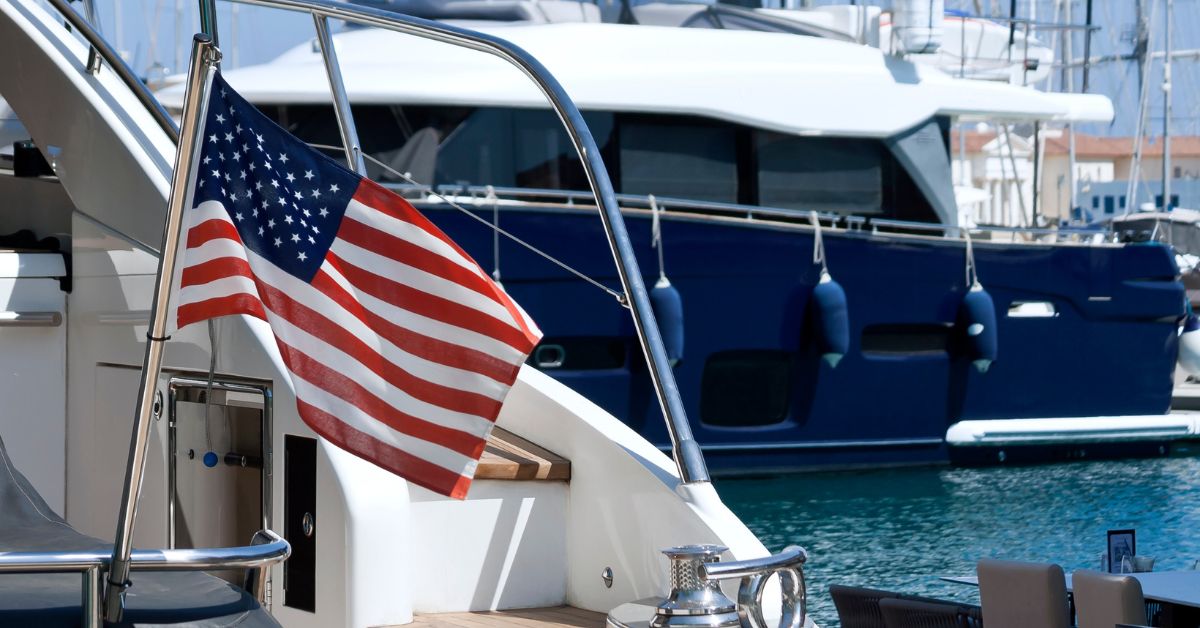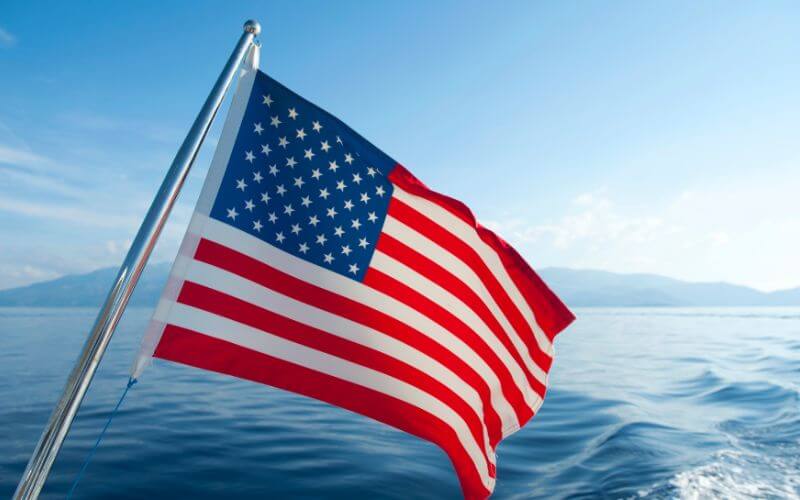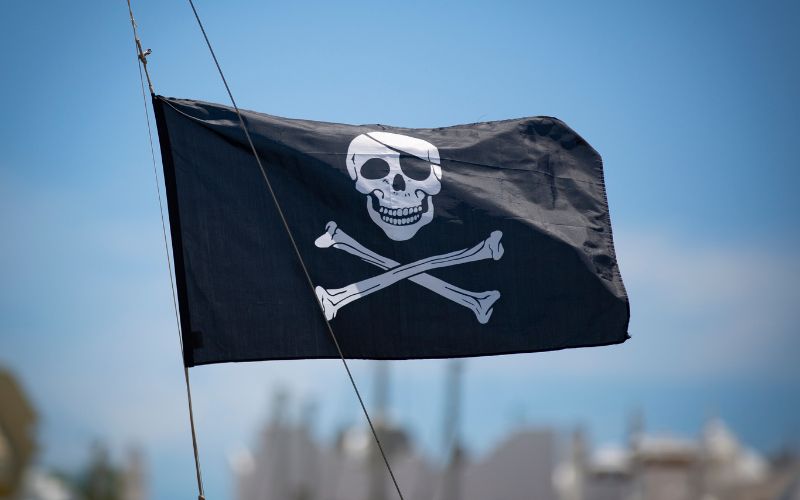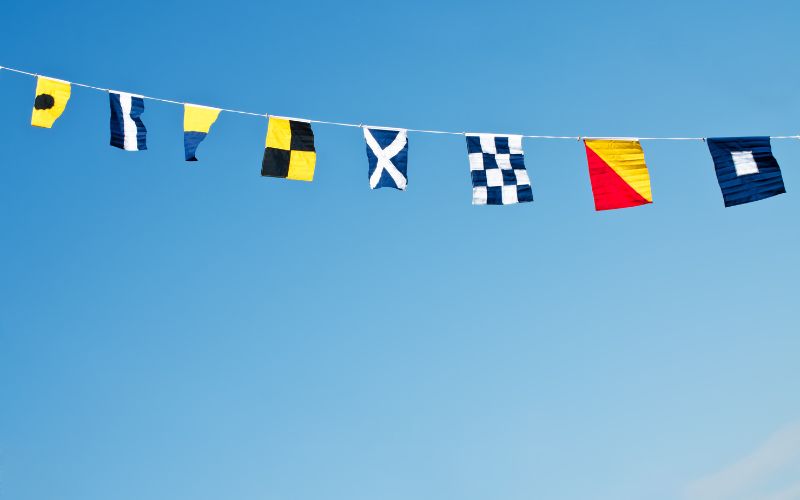Boat flags are colorful and symbolic signals that serve multiple purposes on boats. The purpose of boat flags is to communicate messages and signals to other boaters, marine authorities, and the general public.
They indicate various important information such as the boat’s nationality, the presence of dangerous cargo, the name of the ship or yacht club, geographical signals, and much more.
Additionally, boat flags are often used as decorative items, contributing to the coastal décor of the boat. They can showcase the personality of the boat’s owner or represent a sailing organization. Boat flags are a great way to personalize your nautical vessel and have some fun along the way.
Types of Boat Flags
1. American Flags on Boats
When it comes to displaying national pride and patriotism on the water, American flags are a common sight on boats. Not only does flying the American flag on a boat showcase a love for the country, but it also adheres to maritime customs and traditions.
Whether a small recreational vessel or a large yacht, displaying the US flag allows boat owners to demonstrate their allegiance and honor the values the flag represents.
The U.S. Yacht Ensign is a variation of the American Flag which is used in lieu of the traditional American Flag on yachts that are only traveling with U.S. waters.
History of the American Flag on Boats
The history of the American flag on boats is rooted in the evolution of nautical flags and their significance in communication between ships. As early as the 19th century, flags were used to convey messages and identify ships at sea.
With its iconic red, white, and blue design, the American flag became an important symbol of national pride and patriotism. It was incorporated into the flag communication system, allowing ships to display allegiance and send messages to fellow vessels.
Over the years, regulations and guidelines were established for flying the American flag on boats. These regulations ensure that the flag is displayed with the respect and dignity it deserves. Using the U.S. flag on boats has become standard on military vessels, recreational boats, and yachts.
Regulations for Flying an American Flag on a Boat
When displaying the American flag on a boat, specific regulations and guidelines should be followed to ensure the flag is treated with proper respect and dignity. These regulations help maintain the integrity of this symbol of national pride and patriotism.
Firstly, Flag sizes for boats need to match their size and style. Here are some guidelines:
|
Boat Length |
Power Boats | Sailboats | ||
| Private Flag | Yacht Ensign | Private Flag | Yacht Ensign | |
| Under 20′ | 8×12″ | 12×18″ | – | – |
| 20′ | 10×15″ | 12×18″ | 10×15″ | 16×24″ |
| 25′ | 10×15″ | 16×24″ | 10×15″ | 16×24″ |
| 30′ | 12×18″ | 16×24″ | 12×18″ | 24×36″ |
| 35′ | 12×18″ | 24×36″ | 14×21″ | 24×36″ |
| 40′ | 14×21″ | 24×36″ | 14×21″ | 24×36″ |
| 45′ | 14×21″ | 24×36″ | 16×24″ | 2.5×4′ |
| 50′ | 16×24″ | 2.5×4′ | 20×30″ | 2.5×4′ |
| 55′ | 16×24″ | 2.5×4′ | 20×30″ | 2.5×4′ |
| 60′ | 20×30″ | 2.5×4′ | 20×30″ | 2.5×4′ |
| 70′ | 20×30″ | 3×5′ | 24×36″ | 3×5′ |
| 80′ | 24×36″ | 3×5′ | 24×36″ | 3×5′ |
| 90′ | 24×36″ | 4×6′ | 30×48″ | 4×6′ |
| 100′ | 30×48″ | 4×6′ | 30×48″ | 4×6′ |
The yacht ensign should be the largest flag on the boat regardless if it’s a power boat or a sailboat. All other flags should be smaller.
The positioning of the flag is also essential. It should be flown from a flagpole or staff, positioned either at the bow (front) of the boat or the stern (back) if that is where the boat’s design allows.
Additionally, the flag should be flown from sunrise to sunset. If the flag is to be flown at night, it must be adequately illuminated to remain visible. Illumination can be achieved using lights specifically designed for this purpose.
Lastly, it is crucial to handle and display the flag with respect. It should never touch the water or be allowed to touch the ground. It should be properly folded and stored safely and respectfully when not in use.
2. Substitute Flags
Substitute flags are employed when the national flag is not suitable or available due to adverse weather conditions, damage, or other circumstances. These flags are designed to resemble the national flag in colors and patterns, allowing vessels to represent their country still while navigating the seas.
3. Courtesy Flags
Courtesy flags, on the other hand, serve as a sign of respect and adherence to local customs when sailing in foreign waters. By flying the courtesy flag of the country they are visiting, boaters demonstrate their awareness and willingness to respect the laws and regulations of the host nation.
4. Pirate Flags for Boats
If you want to add adventure and intrigue to your boating experience, consider flying a pirate flag on your boat. Pirate flags, also known as Jolly Roger flags, have long been associated with the swashbuckling world of pirates and have become iconic symbols of adventure on the high seas.
These flags typically feature a skull and crossbones design, meant to strike fear into the hearts of fellow sailors. You can choose from various pirate flag designs, from traditional black and white skulls and crossbones to more colorful and elaborate versions.
History Behind Pirate Flags Flying for Boats
Pirate flags, or Jolly Rogers, emerged during the Golden Age of Piracy in the 17th and 18th centuries. These flags, featuring iconic symbols of pirate lore, were raised to announce the pirates’ arrival and intimidate their victims.
Notable figures like Edward Teach, known as Blackbeard, and Calico Jack Rackham had particularly striking flags. Blackbeard’s displayed a horned skeleton with an hourglass and a stabbed, bleeding heart. Rackham’s flag showed crossed swords under a skull, highlighting his daring nature.
Pirate flags often bore skulls, crossbones, and swords as grave warnings of their intents to loot. A red flag promised a fierce fight, and a black one signified no mercy was forthcoming.
Today, these flags are popular symbols of rebellion and adventure. Their intriguing designs feature in films, literature, and even Halloween costumes, reflecting our enduring fascination with the pirate world.
5. Nautical Flags
Nautical flags are an essential part of maritime tradition and communication. These brightly colored flags, often flown from boats, yachts, and ships, carry important messages that can be understood by sailors and vessels from afar.
Each flag represents a specific meaning or message, allowing for effective communication between ships, yacht clubs, and recreational boaters. Nautical flags can convey important information regarding dangerous cargo, indicate numeral pennants to represent specific numbers, or display the names of ships and yacht clubs.
The Nautical Alphabet
In the bustling world of maritime operations, effective communication is paramount for the safety and efficiency of vessels. One invaluable tool in this realm is the Nautical Alphabet. A set of visual signals that utilize flags and pennants to convey specific scenarios and requests between ships.
Each alphabet letter is assigned a unique flag or pennant, allowing easy identification and interpretation. For example, the letter “A” is represented by a red and white flag, indicating “Alpha.” This letter flag is hoisted to signal that a vessel has a diver down and caution must be exercised.
Other notable letters include “B” for “Bravo,” represented by a blue and white flag, signaling the presence of dangerous cargo; “C” for “Charlie,” indicated by a blue and yellow pennant, signifying that a vessel needs assistance; and “N” for “November,” a red and yellow pennant used to indicate that a ship is carrying dangerous chemicals.
The Nautical Alphabet is a universal language for sailors, enabling swift and accurate information relay during critical situations. By understanding and adhering to these flags and pennants, maritime personnel can enhance safety, prevent accidents, and facilitate smoother operations.
Solo and Combined Flags
Boats can display between 1 and 7 nautical flags at any given time. The International Code of Signals governs the use of these flags, providing a standardized system for communication at sea. Solo flags, when flown individually, possess their unique meanings.
However, the real power of these International Code Signal flags lies in their combination. By hoisting different flags together, they create a specific message or instruction for other boaters to understand. These combinations can convey requests for assistance, navigational maneuvers, or alerts to potential dangers.
For instance, the “A” flag signifies a vessel’s need for assistance altering its course. While the “R” flag indicates the intention to maneuver reversely. By using these flags appropriately, boats can communicate their intentions, thereby reducing the risk of collisions and maintaining a safe navigation environment.
Nautical Flag Origins and History
Nautical flags have a rich history spanning centuries and are essential to maritime communication. Flags for signaling between ships date back to ancient times when various civilizations utilized visual symbols to convey messages across vast distances.
However, it was in the 19th century that a comprehensive system of nautical flags was established. In 1855, the International Code of Signals was introduced, standardizing the use of flags for communication between vessels. This significant development allowed ships from different nations to understand each other’s signals, enhancing safety and efficiency in maritime operations.
Nautical flags have evolved to meet the changing needs of the shipping industry. Initially, the flags were primarily used to convey important messages, such as distress signals or requests for assistance. Today, they serve multiple purposes, including decoration and identification of boats and yacht clubs.
6. Custom Boat flags
These are a popular option, allowing you to create a unique flag for your boat. You can personalize these flags with designs such as college team logos, military flags, or religious and political-themed flags.
Wrapping Up
Boat flags hold significant meaning and practical importance in the world of boating. From indicating the nationality of a vessel to communicating essential messages and signals, these flags play a crucial role in maintaining safety, promoting camaraderie among boaters, and respecting maritime traditions.
The vast array of boat flag designs and their unique symbolism makes for an exciting and visually appealing aspect of the boating experience. Moreover, not only professionals and seasoned sailors are limited to boat flags. It is an inclusive practice that welcomes and educates novices, fostering a sense of community on the water.
So, whether you’re a seasoned sailor or a recreational boater, getting a flag for your boat can help enhance your boating experience, showcase your identity, and contribute to the rich history and traditions of the maritime world.
Reference







